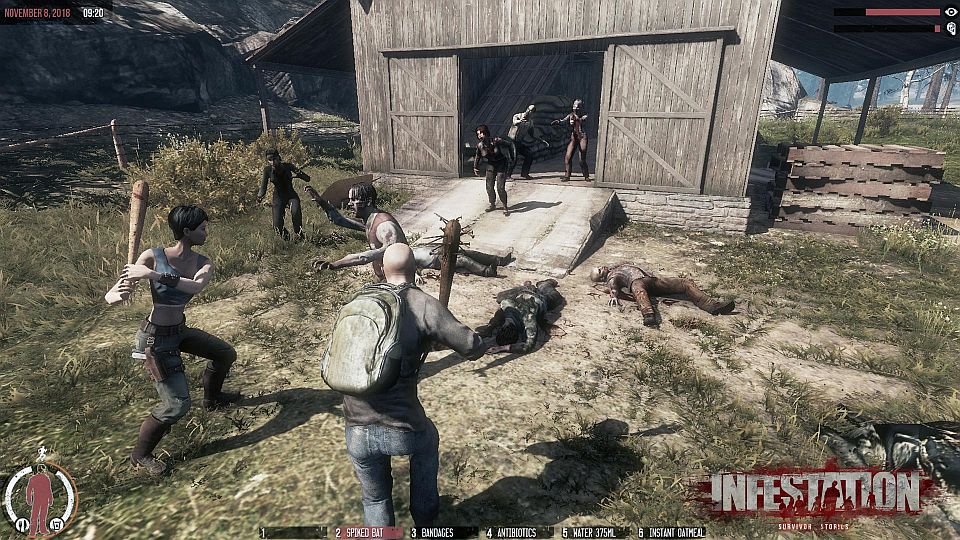Developing a multiplayer online game is a difficult task for a developer of any size, with many technical challenges to overcome. The marketing and PR task is also difficult, and many smaller developers don’t appreciate the difficulties involved — and often don’t have the necessary skills to handle the task. Hammerpoint Interactive encountered many of these marketing difficulties and more problems in the long process of turning a multiplayer game into a successful business.
 Executive producer Sergey Titov
Executive producer Sergey Titov
The [a]list daily spoke with executive producer Sergey Titov about the development of Infestation: Survivor Stories (formerly The War Z) and some of the lessons learned in the last two years. While the game had a rocky start, the picture looks pretty good at this point. “We have slightly over 2.5 million users in the game, I think it’s quite a good achievement for a small indie game,” said Titov. ” We have about 400,000 players every month, and 100,000 daily. The game is pretty healthy right now.” Getting there was not easy, Titov admits. “We had a weird ride which we didn’t anticipate,” he said.
Development of the game began in the second half of 2011, and Titov admits the design changed substantially along the way. “The game we planned back there wasn’t what we launched,” Titov said. In mid 2012 Day Z launched for Arma 2 and became hugely popular, and this inspired the Hammerpoint team. “What we did was the same thing Riot Games did with DOTA,” Titov said. “Riot took the MOBA and made it more accessible, more appealing to a broader audience.”
“While we didn’t exactly take the Day Z model for ours, our game was hugely inspired by it,” Titov said. But it wasn’t the same game by any means. “We had our own vision of what the game should be and how it should play. In some ways what we did was improved version of Day Z.” The big mistake Hammerpoint made was in naming the game, both from a legal standpoint and a marketing standpoint. “The name was one of the first mistakes, it was terribly chosen,” Titov admits. “We set up ourselves in the minds of consumers as Day Z copycat.”
Titov said the team was surprised by the excitement that the game generated. “When we announced the game, the response was huge. We never expected that level of response from press and consumers,” Titov said. They launched a closed alpha in mid-October of 2012, and by the time the game launched in mid-December they were already close to 800,000 copies sold. Then they ran into a problem with Steam. “What happened with Steam was totally our mistake. We took our description of the game from our web site, which was our road map, and put that on Steam. So the Steam store description was half features in the game and half the features that were going to be in the game,” said Titov. There was an uproar from fans who purchased the game based on the description and then found many of the features described weren’t implemented in the game, and the game was pulled from Steam as a consequence.
“From our perspective it wasn’t a big deal because Steam sales were about 20 percent of our sales, but for the media perspective it was ‘the game is launched, the game is pulled, the game is dead,” Titov said. Steam offered a conditional refund, and usually Steam doesn’t do that, Titov noted. He added that only a very small percentage of people actually requested the refund. In the end, after a few months of fixes and added features, the game was returned to Steam where it does well, but still less than half of the game’s overall revenue.
Early reviews of the game were caustic and critical, with reviewers who were enthusiastic about early alpha versions savaging the game upon its release. The controversy on Steam no doubt contributed to the reviewer’s impressions, and the lack of many promised features colored their outlook. The game also had a name change, when Hammerpoint’s trademark application for The War Z was determined by the USPTo to be too close to Paramount’s movie title World War Z. Hence the name change to Infestation: Survivor Stories, which Titov says is a better representation of the game anyway.

The entire process left Titov with some lessons learned. “I thought about that a lot, and there are lots of things I would do differently now,” Titov said. “I really don’t have that many regrets. If lots of those mistakes didn’t happened, we wouldn’t have learned.”
Titove has some advice for developers: Manage expectations, listen to the community, and build a robust infrastructure. “Manage the expectations of your communities. Don’t promise anything that’s not in your product right now,” Titvo said. “Even if you know that you will deliver the feature in six months, there will be lots of broken hearts in a month or two or three. Features that you promised even if you promise at a future date, they will be there tomorrow. If you promise you need to be very very clear.”
The second lesson is the importance of community.”We really had a very vocal and very harsh community towards us. If our community felt something was wrong, they never held back,” Titov said. “For us it’s a blessing. Listen to your community, because they are your biggest ally and your biggest marketing tool. We spent almost no dollars advertising the game, and hardly any money on PR. Most of our players are gained by word of mouth. Most of our players came to the game way after we got bad reviews, shitty Metacritic and after everybody hated us in the press. If people like what they see they will bring their friends.”
Last but not least, acknowledge your capabilities. “When we launched the game we had about 40,000 concurrent users in real time. That’s a pretty big number even for a larger company,” Titov noted. “During all that time we didn’t have any major downtime. We had little setbacks and we survived them. But the game was essentially up 24/7. Our whole infrastructure was managed by one IT guy.”

